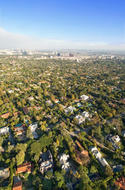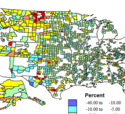Ordos, in China's Autonomous Region of Inner Mongolia (equivalent to a province) has received international notoriety as a "ghost city." I had already visited one other ghost city and found the reports considerably exaggerated (The Zhengzhou New Area in Henan, a commercial and residential district). But Ordos has received by far the most publicity. read more »
Newgeography.com - Economic, demographic, and political commentary about places
The U.S. Cities Creating The Most White-Collar Jobs, 2016
The information sector may have glamour and manufacturing, nostalgia appeal, but the real action in high-wage job growth in the United States is in the vast realm of professional and business services. This is not only the largest high-wage part of the economy, employing just under 20 million people at an average salary of $30 an hour, it’s also one the few high-wage sectors in which employment has expanded steadily since 2010, at more than 3% a year, adding nearly 3 million white-collar jobs. read more »
- Login to post comments
So You Want a Revolution
You say you want a revolution
Well you know
We’d all want to change the world.____ The Beatles (1968)
Apparently not. Not any more. Not everyone wants to change the world. To the Beatles in 1968, when young people aged less than 30 added up to 52% of the US population, it might have looked like everyone wanted a revolution and that a nascent movement had a deep reserve of younger cohorts ready to push for change. But the percentage of the population aged less than 30 today is only 39% and falling. read more »
- Login to post comments
A Different Approach to Redevelopment
As part of a thought experiment I examined one specific neighborhood in a typical small city in Georgia. I’m using this town not because it’s unique, but because it’s absolutely normative. I could do the same analysis on the town where my mom, sisters, and brother live in southern New Jersey and it would be nearly identical. This is Everytown, USA. read more »
- Login to post comments
Silicon Valley and the Logic of the Globalized Economy
The technology driven global economy is brutally competitive and has put enormous stress on businesses to adapt or die. read more »
- Login to post comments
Election 2016: Peak Transformation
Barack Obama came to office with a promise of “fundamentally transforming the United States.” Through what one admirer calls “a profound course correction engineered by relentless government activism,” Obama has, indeed, transformed the country and shifted it to what now passes for the Left agenda on America’s role in the world, the environment, gender issues, labor rights and untrammeled executive power over both Congress and local governments. read more »
- Login to post comments
The Shorter Commutes in American Suburbs and Exurbs
An examination of American Community Survey (ACS) data in the major metropolitan areas of the United States shows that suburbs and exurbs have the shortest one-way work trip travel times for the largest number of people. The analysis covers metropolitan areas with more than 1,000,000 population in 2012, from the 2010-2014 ACS (2012 average data) using the City Sector Model.
The City Sector Model read more »
- Login to post comments
Population Change, 2015: Not Very Good News for Those Angry White Men
Data on population growth from 2010 to 2015 show a continuing concentration of people in metropolitan areas, especially in the large areas with over a million people, where presumably traditional values are most challenged. I show an amazing table, in which I have disaggregated population change by type of settlement, from the million-metro areas to the purely rural counties, comparing growth amounts and rates, plus noting how these areas actually voted in 2012. read more »
- Login to post comments
Challenging Nordic Myths
Hillary Clinton, Bernie Sanders and numerous other American politicians want to increase taxes, regulate businesses and create a society where government takes responsibility for many aspects of daily life. If you are sick, the public sector should pay for your treatment and give you sick leave benefits. If you quit your job, taxpayers should support you. If you have a low income, the government should transfer money from your neighbor who has a better job. read more »
Learning from Medellín with Alejandro Echeverri
“I think, if you want to write a new narrative at some specific moment in the story of a city, it is important that you have to feel the transformation and see the transformation. So the physical transformation is important but always there is more a spiritual thing, as happens with emotional connections and inspirational things.” ______Architect Alejandro Echeverri. read more »
- Login to post comments






















